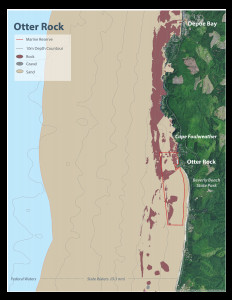Nestled along the captivating central Oregon coast, near the charming unincorporated community of Otter Rock, lies the remarkable Otter Rock Marine Reserve. Despite being Oregon’s smallest marine reserve, spanning just 1.2 square miles, Otter Rock offers an incredibly rich and diverse marine ecosystem waiting to be explored. This protected area is a sanctuary where all removal of animals and seaweeds is prohibited, ensuring the preservation of its natural wonders and contributing to ocean conservation. Ocean development is also restricted, allowing the area to thrive in its pristine state.
Unveiling the Unique Ecosystem of Otter Rock
Otter Rock’s uniqueness stems from its diverse habitats, both above and below the waterline, making it a fascinating destination for nature enthusiasts and scientists alike.
Beneath the surface, the marine reserve boasts a captivating underwater landscape. At its northern edge, extensive rocky intertidal habitats stretch along the shoreline. These intertidal zones are dynamic environments, alternately submerged and exposed by the tides, revealing a vibrant community of marine life. Common inhabitants include resilient mussels clinging to rocks, predatory sea stars navigating the terrain, colorful sea anemones swaying in the currents, armored chitons grazing on algae, and a stunning array of seaweeds in various shapes and hues. Venturing further underwater, you’ll discover shallow rocky reefs teeming with life, swaying kelp forests providing shelter and food, soft bottom habitats supporting different species, and unique sand dollar beds.
 Seafloor habitat map for Otter Rock Marine Reserve
Seafloor habitat map for Otter Rock Marine Reserve
Click on the seafloor habitat map to explore the underwater landscape of Otter Rock Marine Reserve.
Above the water, Otter Rock Marine Reserve is easily accessible through the renowned Devils Punchbowl State Natural Area. This iconic park itself is a major attraction on the Oregon Coast, famous for its dramatic punchbowl formation carved by the ocean waves. Around Otter Rock, visitors can indulge in classic Oregon coast experiences. Explore fascinating tide pools teeming with miniature ecosystems, observe harbor seals basking on the rocks just offshore, and enjoy leisurely strolls along the expansive sandy beach of Beverly Beach State Park, just a short distance away. When exploring the tide pools and observing wildlife, remember to practice responsible etiquette to minimize disturbance to these delicate environments and animals. Resources on tidepool etiquette and seal viewing guidelines are available to help visitors enjoy and protect these natural treasures. Three picturesque offshore islands mark the western boundary of the marine reserve, adding to the scenic beauty of the area. The charming towns of Depoe Bay and Newport are also located nearby, offering additional amenities and attractions for visitors exploring the Otter Rock region.
Planning Your Visit to Otter Rock, Oregon
For those planning a trip to Otter Rock, Oregon, and its marine reserve, numerous activities await. An activity guide is available to help you plan your itinerary, suggesting hikes with breathtaking viewpoints and other ways to experience the natural beauty of the area.
| Key Information about Otter Rock Marine Reserve | |
|---|---|
| Harvest Restrictions Began | January 1, 2012 |
| Monitoring Began | 2010 |
| Size | Reserve: 3 sq km (1.2 sq mi) |
| Depth Range | 0-18 m (0-59 ft) |
| Habitats | Emergent rocks, bedrock and boulders, patches of kelp beds, areas of soft bottom, and sand dollar beds. Rocky intertidal habitats. |
| Habitat Connectivity | Rocky habitats extend beyond the reserve. |
| Prior Fishing Pressure | Relatively low due to limited rocky reef and shallow depths. |
| Monitoring Comparison Area | Cape Foulweather |
The Importance of Design and Monitoring at Otter Rock
The Oregon Department of Fish and Wildlife (ODFW) Marine Reserves Program implements tailored monitoring strategies for each of Oregon’s marine reserves. These strategies consider factors like size, habitats, depth, fishing history, and unique characteristics.
Otter Rock Marine Reserve, being a small and shallow reserve with limited subtidal rock habitat and historically low fishing pressure, presents a unique monitoring scenario. While dramatic changes directly attributable to reserve protections may be less pronounced compared to areas with high prior fishing activity, Otter Rock remains a crucial site for long-term data collection. The ongoing sampling efforts both inside the reserve and at a comparison site like Cape Foulweather are invaluable for tracking long-term changes in marine communities. This continuous monitoring provides essential data for understanding broader trends in Oregon’s nearshore ocean environment, information that is vital for effective marine resource management.
Furthermore, Otter Rock serves as an ideal “scientific training ground.” Its accessibility and diverse habitats make it perfect for local scientists to test innovative research approaches, refine their skills, and deepen their understanding of nearshore ocean ecosystems. Volunteer scientific divers receive training in this area, ODFW staff conduct pilot studies to improve monitoring methodologies, and Oregon State University researchers utilize the reserve for juvenile fish settlement studies. Otter Rock Marine Reserve, though small in size, plays a significant role in marine research, conservation, and education on the Oregon coast.